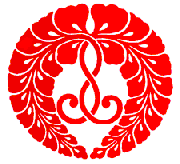

The information contained here was originally published in 1983 by the
Research & Publication Committee of the Buddhist Churches of America.
Although the authors are not listed, the preface is by the Chairman of the
Committee, Rev. Hoshu Y. Matsubayashi, and the forward is written by Rev. Ken
Yamaguchi.
When you enter a Jodo Shinshu temple, you will see before you a typical
Buddhist shrine, very ornate. At first glance for the unoriented, it may give
the impression that it is an idol worshipping shrine. However, when given an
opportunity to study the various points of the shrine, you realize that, far
from being an idol worshipping shrine, the great and wonderful Teachings of the
Buddha are embraced in the symbolic features constituting this shrine.
Gold is used in the grill work because it does not tarnish, just as the Teachings of the Buddha do not become tarnished, but will stay good and pure for all mankind forever.
The figure of Amida Buddha that you see in the center shrine is a symbol of
Supreme Enlightenment. It symbolizes Universal Wisdom and Compassion (the
essential contents of Enlightenment). Every aspect of the statue shows the
meaning of Enlightenment in motion. The statue is leaning forward, representing
the dynamic aspect of Wisdom and Compassion moving towards us beings who are
caught in ignorance. The hand gestures (mudra) represent the actions of Amida
Buddha. The right hand is raised, with the thumb and index finger joined to form
the circle of perfection (the Buddha Dharma is perfect and eternal) and seeking
to awaken man to Faith and Enlightenment. A unique feature of Amida Buddha is
His standing position symbolizing the Compassion that confirms blessings on all,
uplifting man to Faith and Enlightenment. A unique feature of Amida Buddha is
His standing position symbolizing his eternal activity of bringing Enlightenment
to all sentient beings. The kohai (background of light) is made up of 48
rays of light to represent the 48 Vows which Bodhisattva Dharmakara perfected to
become Amida, the Buddha of Infinite Light and Life and the Buddha of ultimate
Wisdom and Compassion.
The Amida Buddha is standing on a fully opened lotus
flower, representing the symbol of Enlightenment. It is a flower that grows in
mire, yet the flower stays pure and lovely. Thus, we too might live in poor and
bad surroundings, under imperfect conditions, yet stay pure and clean. Amida's
eyes are half closed, symbolizing the Truth for to be able to see the whole
truth of life, one must be able to look within oneself as well as what is out
there in the physical world.
Often times a scroll with the Six Chinese
characters reading Na Mu A Mi Da Butsu is used in place of the statue of Amida
to emphasize that the Nembutsu is the primary saving nature. Both forms are
syonymous and are considered the central objects of reverence.
The four vertical pillars surrounding the statue of Amida Buddha symbolize the Four Noble Truths: the sufferings and sorrows of the world, the causes of these sufferings and sorrows, their cessation, and the path that leads to the cessation of these sufferings and sorrows. This path is designated in the Eightfold Path.
A scroll bearing the image of Shinran Shonin (1173-1263 A.D.), the founder of Jodo Shinshu (True Pure Land), hangs in the shrine to the right of the shrine of Amida Buddha. In the shrine to the left hangs a picture of Rennyo Shonin (1414-1499), the eighth descendant of Shinran Shonin. Rennyo Shonin is largely responsible for the restoration of Jodo Shinshu Teachings asa major force of Buddhism in Japan.
To the left and right of the central shrine, two pairs of lanterns are suspended from the ceiling. The pair on the outside are exposed oil lamps suspended on a circular band decorated with chrysanthemums. These lamps are called kiku rinto (chrysanthemum lamps). The circular band represents the Light of Wisdom and Compassion which illuminates the ten directions, symbolizing the whole universe. The inner pair of lanters are enclosed lanterns known as tsuri toro (hanging lanterns).These lanterns can be traced back to the time of the historical Buddha when they were used by traveling monks at night so they could see to avoid stepping on live creatures.
There are six kinds of offerings which can be placed before the shrine:
These offerings correspond to the six senses of the body and mind. The six offerings are a declaration of reverence and gratitude, and a declaration of our intention to hone our six senses to the point where oneself (and therefore the world), is seen clearly as it truly is.
There are many gatherings at the temple where people of all ages attend.
These mass gatherings provide the opportunities to put into practice, and to
actually experience the Teaching of the Buddha. It is just as important, if not
more important, to make the Teachings a part of our daily lives as we merely
have to learn its words.
We hope this brief explanation will provide
information and understanding of this, the greatest teaching available to
benefit all mankind.
 Namu Amida Butsu
Namu Amida Butsu 
![]()